A2P SMS Market Size and Share
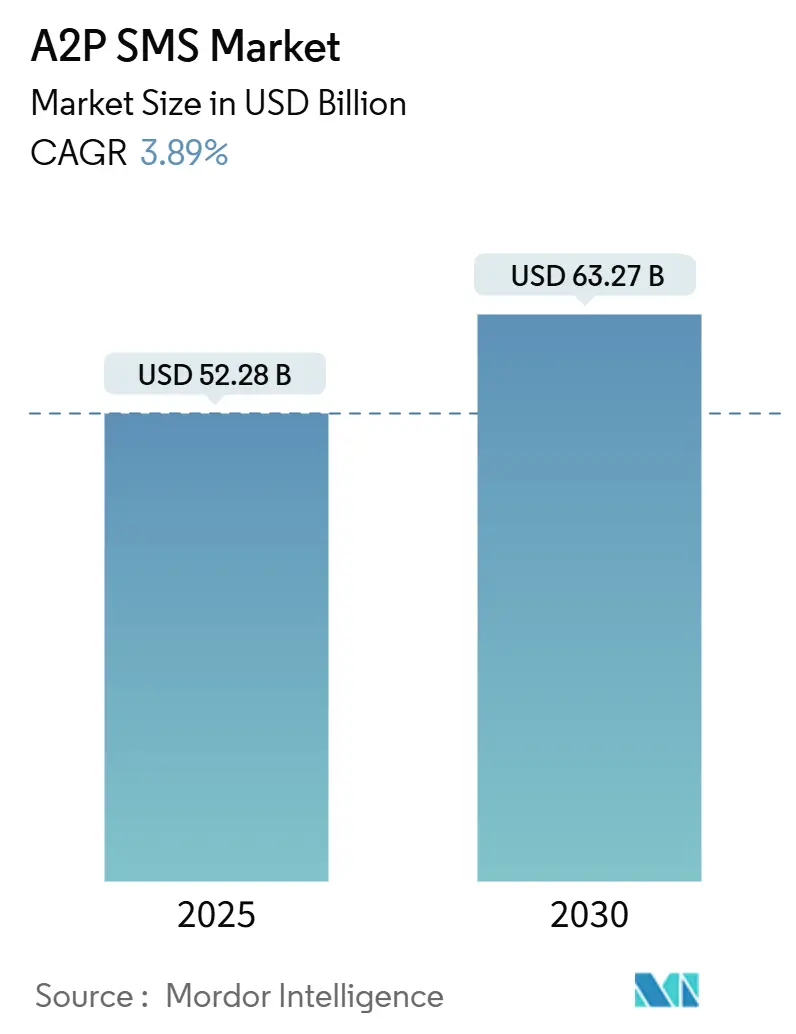
A2P SMS Market Analysis by Mordor Intelligence
The A2P SMS market stands at USD 52.28 billion in 2025 and is set to reach USD 63.27 billion by 2030, advancing at a 3.89% CAGR. Cloud deployments, SME adoption, and security-driven traffic underpin this measured expansion, even as RCS and passkeys unsettle traditional volumes. Persistent demand for high-assurance messaging in financial services, healthcare scheduling, and e-commerce checkout keeps the A2P SMS market firmly embedded in critical business workflows. Provider consolidation, carrier fee inflation, and API-first delivery models shape competitive dynamics as vendors pivot toward richer, fraud-resilient channels.
Key Report Takeaways
- By deployment mode, cloud infrastructure led with 58.89% of the A2P SMS market share in 2024; on-premise installations will contract while cloud traffic expands at a 6.80% CAGR to 2030.
- By enterprise size, large organizations held 56.47% of the A2P SMS market in 2024, whereas SMEs post the fastest 9.20% CAGR through 2030.
- By application, transactional messaging commanded 40.82% share of the A2P SMS market size in 2024; authentication traffic is projected to grow 7.40% per year through 2030.
- By end-use industry, BFSI accounted for a 29.93% slice of the A2P SMS market size in 2024; healthcare leads growth at an 8.10% CAGR.
- By geography, Asia-Pacific retained 36.78% of global revenue in 2024; the Middle East and Africa region is forecast to pace the field with a 10.50% CAGR to 2030.
Global A2P SMS Market Trends and Insights
Drivers Impact Analysis
| Driver | (~) % Impact on CAGR Forecast | Geographic Relevance | Impact Timeline |
|---|---|---|---|
| Increasing demand for real-time transactional messaging | +1.2% | Global, with concentration in Asia-Pacific and North America | Medium term (2-4 years) |
| Growing need for secure two-factor authentication (2FA) | +0.8% | Global, particularly North America and Europe | Short term (≤ 2 years) |
| Rising mobile-subscriber base and smartphone penetration | +0.6% | Middle East and Africa, with spillover to Asia-Pacific | Long term (≥ 4 years) |
| Surge in e-commerce and omnichannel marketing spend | +0.9% | Global, led by North America and Europe | Medium term (2-4 years) |
| Expansion of network APIs enabling low-code SMS integration | +0.4% | North America and Europe, expanding to Asia-Pacific | Medium term (2-4 years) |
| Regulated business-sender IDs curbing grey-route traffic | +0.3% | Global, with strongest impact in North America | Short term (≤ 2 years) |
| Increasing demand for real-time transactional messaging | +1.2% | Global, with concentration in Asia-Pacific and North America | Medium term (2-4 years) |
| Source: Mordor Intelligence | |||
Increasing Demand for Real-Time Transactional Messaging
Retailers rely on SMS for instantaneous order confirmations during peak events, sending 1.7 billion Black Friday messages in 2024 alone.[1]Infobip, “Black Friday 2024 Traffic Analysis,” infobip.comAn open-rate exceeding 98% sharpens the channel’s advantage over email, prompting banks, airlines, and marketplaces to treat A2P SMS as core infrastructure rather than an ancillary alert tool. Dependable delivery across handset generations cements value in geographies where data connectivity fluctuates, reinforcing the A2P SMS market as an always-on failsafe.
Growing Need for Secure Two-Factor Authentication (2FA)
SMS-based one-time passwords remain ubiquitous despite a 300% rise in SIM-swap fraud over recent years.[2]Federal Trade Commission, “Consumer Sentinel Network Data Book 2024,” ftc.gov Financial institutions prefer universal handset reach and low user-training barriers, sustaining traffic growth even as they layer fraud-analytics tools on top of carrier networks. This safety imperative fortifies the A2P SMS market against wholesale displacement by alternate authenticators in the short term.
Surge in E-Commerce and Omnichannel Marketing Spend
Fashion, beauty, and direct-to-consumer brands post 10x–20x ROI on tailored SMS campaigns, driving incremental spend toward integrated engagement clouds. The ability to combine transactional, promotional, and service updates in a single opt-in thread helps merchants reclaim abandoned carts and manage flash-sale inventory without relying on fragmented social feeds. This revenue linkage enlarges the A2P SMS market footprint across retail sub-verticals.
Expansion of Network APIs Enabling Low-Code SMS Integration
A global ecosystem of carrier-grade APIs is estimated to unlock USD 10–30 billion in CPaaS value, streamlining entry for developers that previously avoided telecom complexity.[3]Ericsson, “Network APIs: The Next Wave of Value Creation,” ericsson.comStandardized endpoints and pay-per-use models shrink onboarding cycles for SaaS firms and IoT projects, widening the A2P SMS market funnel beyond Fortune 500 budgets.
Restraints Impact Analysis
| Restraint | (~) % Impact on CAGR Forecast | Geographic Relevance | Impact Timeline |
|---|---|---|---|
| SMS spam and fraud driving automated filtering | -0.7% | Global, with strongest impact in North America and Europe | Short term (≤ 2 years) |
| Competition from OTT chat and RCS channels | -1.1% | Global, with early adoption in developed markets | Medium term (2-4 years) |
| Inflation-linked SMS termination-fee hikes by MNOs | -0.4% | Global, with regional variations | Short term (≤ 2 years) |
| Passkey adoption diluting SMS-based OTP volumes | -0.6% | North America and Europe, expanding globally | Long term (≥ 4 years) |
| Source: Mordor Intelligence | |||
Competition from OTT Chat and RCS Channels
Apple’s decision to support RCS in iOS 18 brings rich media parity to cross-platform messaging, boosting engagement by 32% versus plain SMS. Brands are piloting verified sender IDs and carousels that exceed SMS capabilities, eroding growth in saturated markets. A2P vendors counter by bundling RCS alongside SMS to preserve volume while shifting traffic toward higher-margin formats.
Passkey Adoption Diluting SMS-Based OTP Volumes
FIDO-based passkeys cut per-message costs and eliminate SS7 vulnerabilities, encouraging banks and social platforms to retire SMS 2FA for non-premium tiers. International A2P authentication traffic is forecast to slide from 88.6% of total messages in 2022 to 63.5% by 2027. Vendors respond with adaptive authentication suites that keep SMS in mixed-method portfolios, cushioning revenue impact but trimming the A2P SMS market growth curve.
Segment Analysis
By Deployment Mode: Cloud Infrastructure Drives Scalability
Cloud implementations captured 58.89% of the A2P SMS market in 2024 and should compound at 6.80% through 2030. Usage-based economics, 4,800-plus carrier links, and AI traffic controls make vendor platforms attractive to enterprises retiring legacy SMPP gateways. Consequently, the A2P SMS market size attributable to cloud delivery is projected to approach USD 40 billion by decade-end.
On-premise systems persist where sovereignty rules mandate in-country storage, but their sub-2% CAGR underscores a drag on total A2P SMS industry momentum. Providers now certify regional data centers to entice those users into hybrid or full public-cloud shifts, preserving addressable volume as compliance barriers subside.
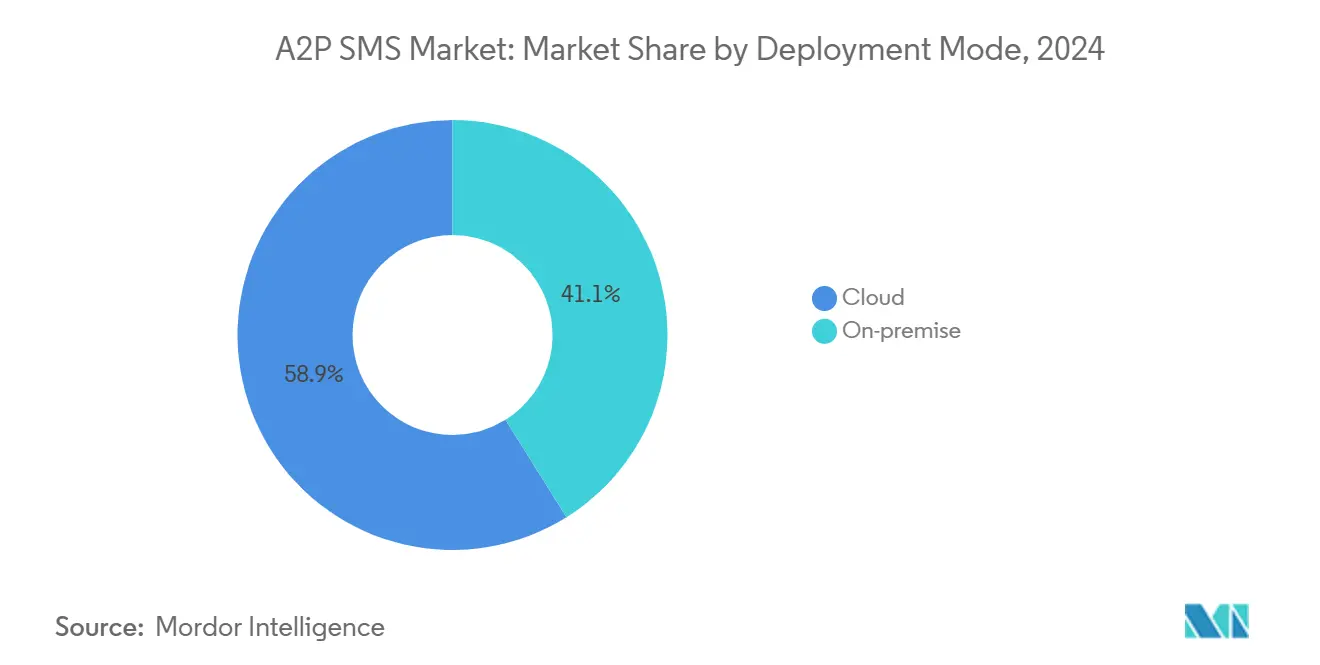
By End-User Enterprise Size: SMEs Accelerate Digital Adoption
Large corporations held 56.47% of 2024 revenue, yet the SME cohort expands fastest at 9.20% as low-code dashboards mask telecom complexity. Affordable bundles and pre-built cart-recovery templates resonate with independent retailers and clinics seeking enterprise-grade touchpoints without capex.
The democratization trend anchors future product roadmaps on intuitive analytics, built-in consent tooling, and localized sender IDs. Platform consolidation around the SME segment signals structural demand that offsets saturation among blue-chip adopters within the broader A2P SMS market.
By Application: Authentication Drives Growth Despite Alternatives
Transactional alerts still hold 40.82% of 2024 volume, but security messages deliver the 7.40% CAGR that underpins incremental revenue. Authentication traffic is forecast to represent 38% of the incremental A2P SMS market size generated between 2025 and 2030, cushioning the deceleration in marketing messages exposed to opt-out fatigue.
Marketing and support notifications remain essential for omnichannel orchestration, though privacy regulations and channel diversification temper growth. Vendors respond by layering analytics across SMS, RCS, and chat apps, ensuring that the A2P SMS market retains a pivotal role inside multichannel engagement suites.
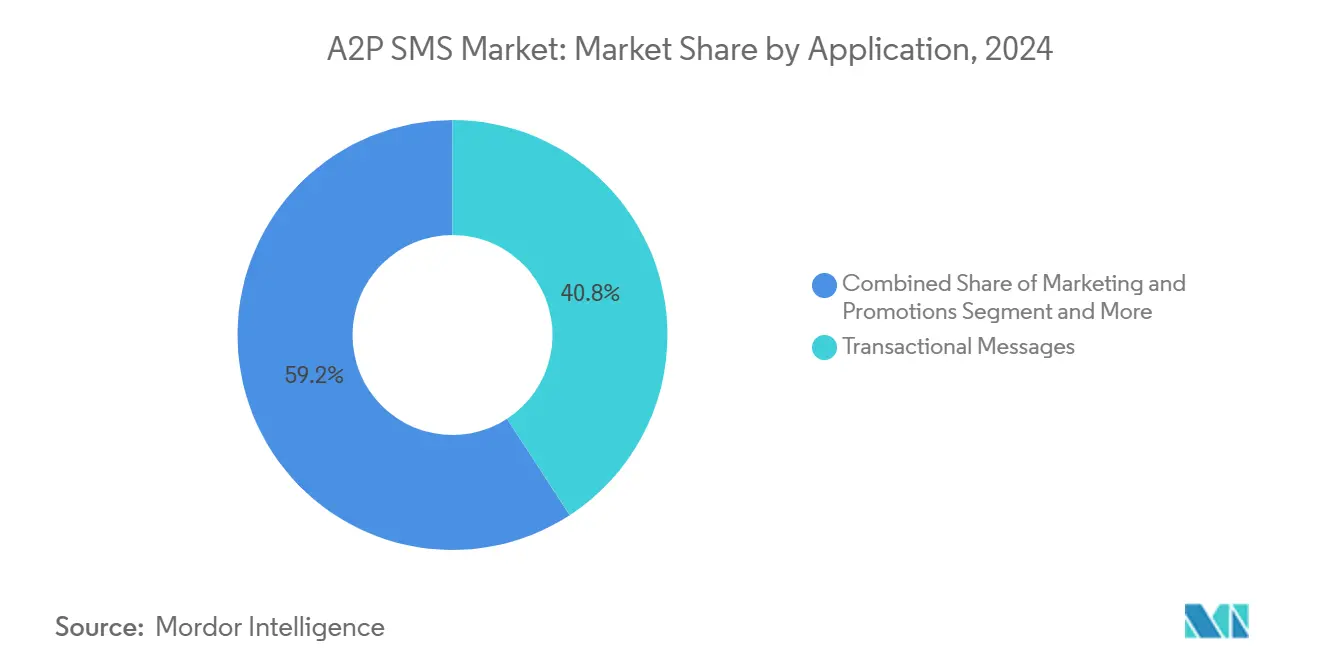
Note: Segment shares of all individual segments available upon report purchase
By End-Use Industry: Healthcare Emerges as Growth Leader
BFSI dominated 2024 with 29.93% share thanks to mandated transaction alerts. Yet an 8.10% CAGR in healthcare signals a changing guard as hospitals automate reminders, prescription prompts, and triage updates. Healthcare’s expanding stake in the A2P SMS market share reflects post-pandemic digital prioritization and strict audit trails that favor SMS over unencrypted chat.
Retail, education, and travel add rounded demand: campus alert systems, gate change notices, and flash-sale coupons all rely on immediate reach. Regulatory alignment (HIPAA, PCI-DSS) steers budget allocation toward vetted CPaaS operators, reinforcing entry barriers within the fragmented A2P SMS industry.
Geography Analysis
Asia-Pacific held 36.78% of global revenue in 2024, buoyed by China and India’s combined 1.8 billion subscribers and pro-carrier regulations that elevate direct connectivity GSMA. Japan and South Korea pilot RCS commerce, while Southeast Asia magnets cross-border e-commerce traffic that lifts regional A2P SMS market transactions.
North America remains premium; carriers raised toll-free SMS fees to USD 0.004 per message in 2025, yet enterprises absorb costs to satisfy stringent TCPA and HIPAA rules. Compliance complexity entrenches established vendors and sustains high ARPU in the continental A2P SMS market.
Europe’s steady climb is guided by GDPR, which standardizes data handling and accelerates cross-border API adoption. Brexit complicates UK routing, but near-real-time VAT refunds and parcel tracking uphold volumes. The Middle East and Africa delivers the 10.50% CAGR headline as mobile-first banking leapfrogs fixed-line constraints; government digital-ID projects rely on SMS for citizen authentication, funneling fresh traffic into the regional A2P SMS market. Latin America grows moderately amid macro volatility, but Brazil’s PIX payments push sustains core authentication flows.
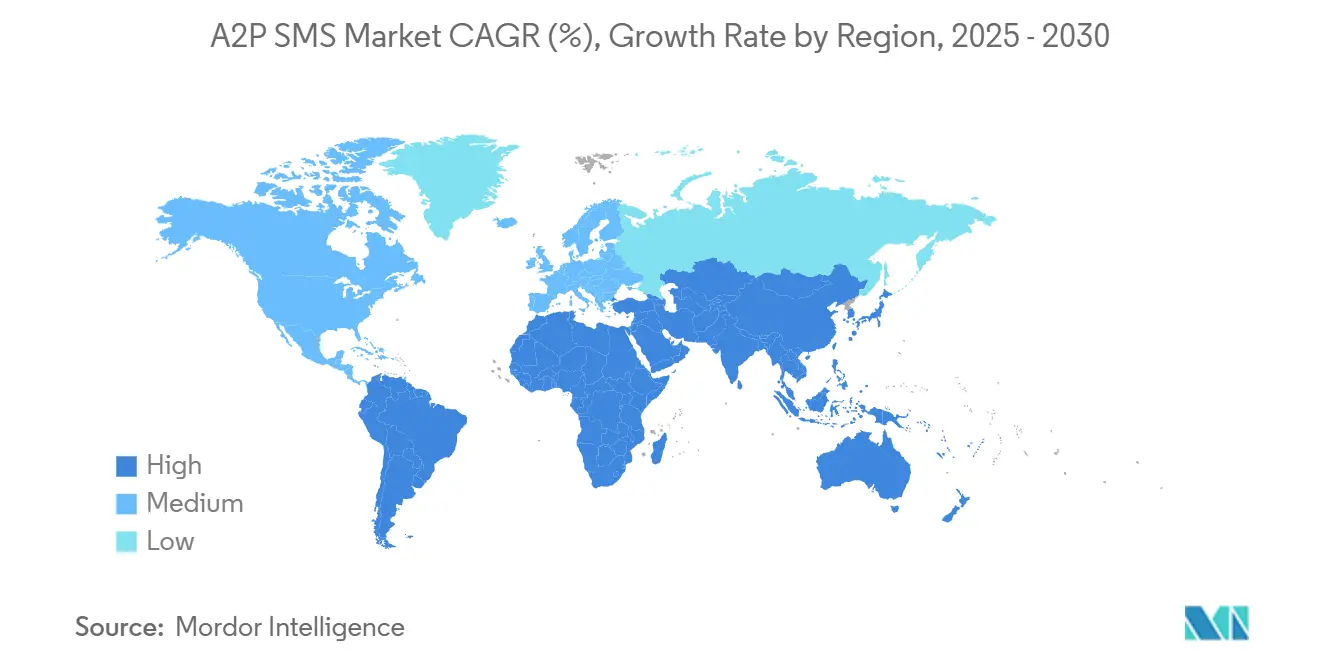
Competitive Landscape
Provider concentration is moderate: Twilio, Sinch, Infobip, Vonage, and Route Mobile collectively process more than 60% of global paid messages yet none exceeds a 20% individual revenue share. Twilio dispatches 14.3 trillion API calls annually, preserving lead scale economies, while Sinch capitalizes on direct carrier stakes in Europe to defend margins. Infobip’s omnichannel pivot secures marquee wins as brands seek RCS and WhatsApp blends.
Strategic MandA illustrates vertical integration. Proximus acquired Route Mobile to graft CPaaS breadth onto carrier assets, and Commify absorbed Text Request to capture SME footholds. Vendors harness AI for pump-in fraud detection and smart routing, reducing gray-route leakage that shaves 3-5 percentage-points off operator take rates. Cloud hyperscalers enter selectively—AWS launched a messaging stack—but long-tail regional nuances temper rapid share grabs, keeping the A2P SMS market fragmented.
A2P SMS Industry Leaders
-
Twilio, Inc.
-
Vonage America LLC
-
Infobip Ltd
-
Sinch AB
-
Route Mobile Ltd.
- *Disclaimer: Major Players sorted in no particular order
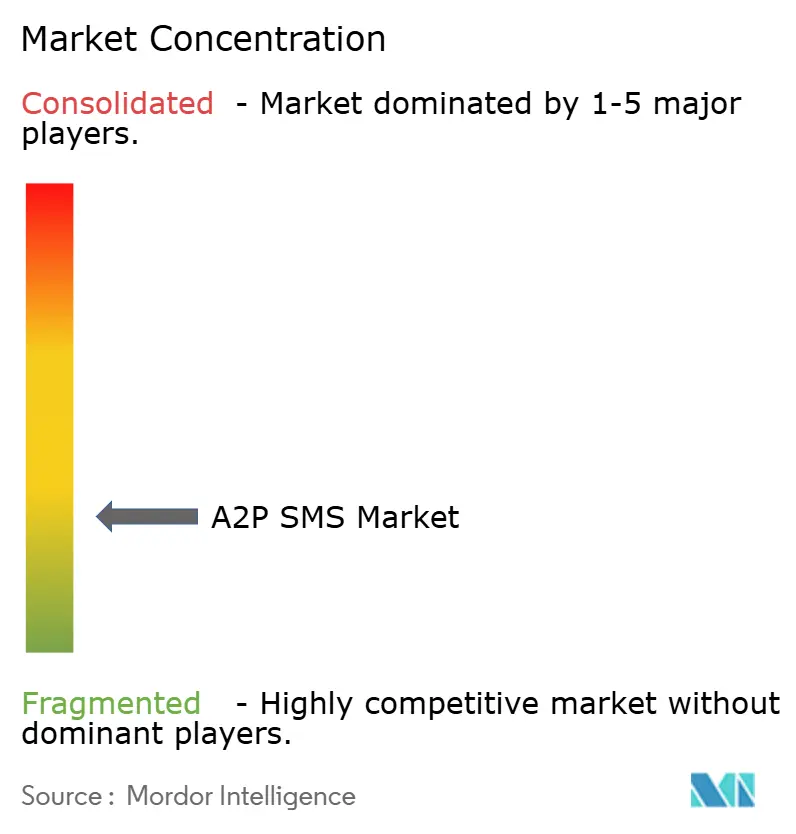
Recent Industry Developments
- January 2025: Infobip and Telekom Business Europe launched an AI-enabled omnichannel suite spanning SMS, RCS, and WhatsApp to unify enterprise outreach.
- January 2025: Attentive surpassed USD 500 million ARR and partnered with Google to accelerate RCS adoption for promotional messaging.
- January 2025: NetNumber and WMC Global integrated registry validation with threat analytics to curb messaging fraud.
- October 2024: Sinch and Singtel debuted the first commercial RCS Business Messaging service in Singapore.
Research Methodology Framework and Report Scope
Market Definitions and Key Coverage
Mordor Intelligence defines the Application-to-Person (A2P) SMS market as all paid, one-way text messages that originate from an enterprise or software platform and terminate on a consumer handset for authentication, alerts, or marketing. Messages delivered by OTT apps, e-mail, RCS, or peer-to-peer texting are not included.
Scope exclusion: Bulk peer-to-peer SMS routes that are later re-sold to enterprises (grey routes) are excluded because pricing and volumes cannot be audited reliably.
Segmentation Overview
- By Deployment Mode
- On-premise
- Cloud
- By End-user Enterprise Size
- Large Enterprises
- Small and Medium Enterprises (SME)
- By Application
- Marketing and Promotions
- Transactional Messages
- Authentication and Security
- Customer Support and Feedback
- Notifications and Alerts
- Others
- By End-Use Industry
- Retail and E-commerce
- BFSI
- Healthcare
- Travel and Hospitality
- Media and Entertainment
- Education
- Others
- By Geography
- North America
- United States
- Canada
- Mexico
- South America
- Brazil
- Argentina
- Rest of South America
- Europe
- United Kingdom
- Germany
- France
- Italy
- Spain
- Russia
- Rest of Europe
- Asia-Pacific
- China
- India
- Japan
- South Korea
- Australia and New Zealand
- Southeast Asia
- Rest of Asia-Pacific
- Middle East and Africa
- Middle East
- Saudi Arabia
- United Arab Emirates
- Turkey
- Rest of Middle East
- Africa
- South Africa
- Nigeria
- Kenya
- Rest of Africa
- Middle East
- North America
Detailed Research Methodology and Data Validation
Primary Research
Mordor analysts interviewed mobile network operators across Asia-Pacific, North America, and MEA, plus CPaaS platform managers and digital retailers. Conversations focused on average selling prices, authentication success rates, and channel-mix shifts, allowing us to validate grey-route leakage assumptions and refine regional traffic ratios.
Desk Research
Our desk work began with traffic and tariff data from regulators and trade bodies such as the ITU, GSMA, FCC, and the Mobile Ecosystem Forum, which clarify national message volumes and termination fees. We mapped these with customs statistics on SIM card imports, central-bank e-commerce spend tables, and regional PSD2 and 10DLC compliance notices that indicate 2FA demand. Company 10-Ks, operator ARPU filings (via D&B Hoovers), and news archives (Dow Jones Factiva) provided price benchmarks and enterprise uptake signals. These examples illustrate, but do not exhaust, the secondary sources reviewed.
Market-Sizing & Forecasting
We applied a top-down build that begins with reported carrier A2P traffic, SIM penetration, and blended termination fees, which are then stress-tested with bottom-up checks from sampled CPaaS invoice volumes and large-sender ASP times message counts. Key variables include: - annual A2P SMS per active smartphone, - share of e-commerce checkouts using SMS OTP, - average international surcharge per message, - growth in RCS substitution, and - carrier firewall-filtered grey traffic. A multivariate regression links these drivers to historical spend and supports our 2025-2030 forecast, while scenario analysis adjusts for rapid RCS adoption.
Data Validation & Update Cycle
Outputs pass variance checks against independent traffic audits and are peer-reviewed by senior analysts. Reports refresh each year; interim updates trigger when major fee, regulatory, or traffic shifts exceed preset thresholds.
Why Mordor's A2P SMS Baseline Earns Decision-Maker Trust
Published market values often diverge because firms mix SMS with OTT channels, apply different fee stacks, or freeze exchange rates.
Key gap drivers here are scope creep into RCS, reliance on unverified global ASPs, and outdated traffic baselines that ignore 10DLC and PSD2 surcharges. Mordor's model isolates billable SMS only, applies dynamic FX, and refreshes with carrier filings every twelve months.
Benchmark comparison
| Market Size | Anonymized source | Primary gap driver |
|---|---|---|
| USD 52.28 B (2025) | Mordor Intelligence | - |
| USD 73.10 B (2024) | Global Consultancy A | Includes OTT/business chat traffic and fixed 2023 FX rates |
| USD 71.50 B (2024) | Trade Journal B | Uses single global ASP, omits grey-route dilution |
These comparisons show that, by grounding totals in audited carrier traffic and refreshed fee schedules, Mordor delivers a balanced, transparent baseline that clients can replicate and defend.
Key Questions Answered in the Report
How big is the cloud segment of the A2P SMS market size today?
Cloud routes accounted for 58.89% of 2024 spending and are projected to approach USD 40 billion by 2030 as enterprises decommission on-premise gateways.
Will passkeys eliminate the need for SMS one-time passwords?
Passkeys will reduce some OTP volumes, yet most enterprises retain SMS fallback for universal device coverage, supporting a 7.40% CAGR in authentication traffic within the A2P SMS market.
Who are the key players in A2P SMS Market?
Twilio, Inc., Vonage America LLC, Plivo, Inc., Infobip Ltd and Sinch AB are the major companies operating in the A2P SMS Market.
Which region shows the fastest growth?
The Middle East & Africa leads with a 10.50% CAGR through 2030, propelled by mobile-first banking, digital ID rollouts, and rapid smartphone adoption.
How fragmented is vendor competition?
The top five providers handle slightly above 60% of global paid messages, yielding a market concentration score of 6, which signals moderate consolidation alongside vibrant regional players.
Page last updated on:



